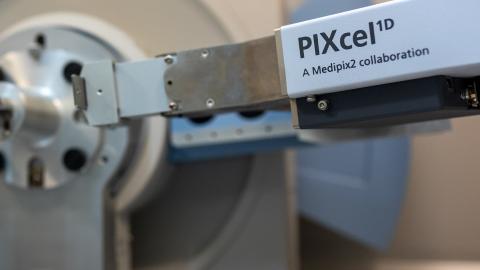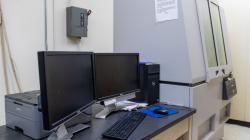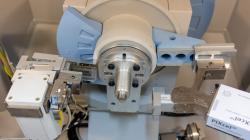PANalytical X'Pert Pro
Location
Marshak Science Building, Room: 904
The City College of New York
160 Convent Ave, New York, NY 10031
Staff
Alexei Bykov, Ph.D.
abykov@ccny.cuny.edu
Phone: 212 650 5548
Cell: 646 725 0270
Scheduling
Fees
Federal rate - $20/h
Non-Federal rate - $44/h
CCNY rate - $11/h
Facility Images
About the facility
This XRD instrument from Panalytical is used primarily for powder diffraction. The X’Pert powder instrument is configured with simple slits and proportional detector for data collection to do phase analysis including Rietveld refinement. The built-in structural database (PDF) allows identification of phases from powder diffraction data.
Features
- X-ray source: Philips high intensity ceramic sealed tube (3kW)
- Wavelength: Cu Ka (1.5405 Å)
- Incident beam optics: Soller slit (0.04 rad), interchangeable divergence fixed slits and masks.
- Diffracted beam optics: Soller slit (0.04 rad), Ni-filter, interchangeable fixed antiscattering and receiving slits.
- Detector: sealed proportional counter
- Sample stage: fixed stage and spinner
- Software: Data Collector, HighScore (Plus)
The instrument has been upgraded with new fast detector (PIXcel1D), diffracted beam monochromator, and sample changer. For more information download the XRD Upgrade Notes and updated SOP (see links below).
Background: X-ray powder diffraction
Powder XRD (X-ray Diffraction) is one of the most widely used x-ray diffraction technique for characterizing materials. The sample is supposed to be in a powdered form (as it follows from the name of the technique) consisting of fine single crystalline grains of material to be studied. The technique is used also for analyzing particles in liquid suspensions or polycrystalline solids (bulk or thin film materials).
The atoms in a crystal are a periodic array of coherent scattering centers and thus can diffract light. Interaction of X-rays with powdered sample creates secondary “diffracted” beams (actually generated in the form of cones) of X-rays related to interplanar d-spacings in the crystalline powder according to Bragg’s Law: nλ = 2d sinθ, where n is an integer, λ is the wavelength of the X-rays, d is the interplanar spacing generating the diffraction, and θ is the diffraction angle.
Powder diffraction data can be collected using either transmission or reflection geometry. Because the particles in the powder sample are randomly oriented, these two methods will yield the same data.
Useful Links
Last Updated: 07/16/2024 13:53


